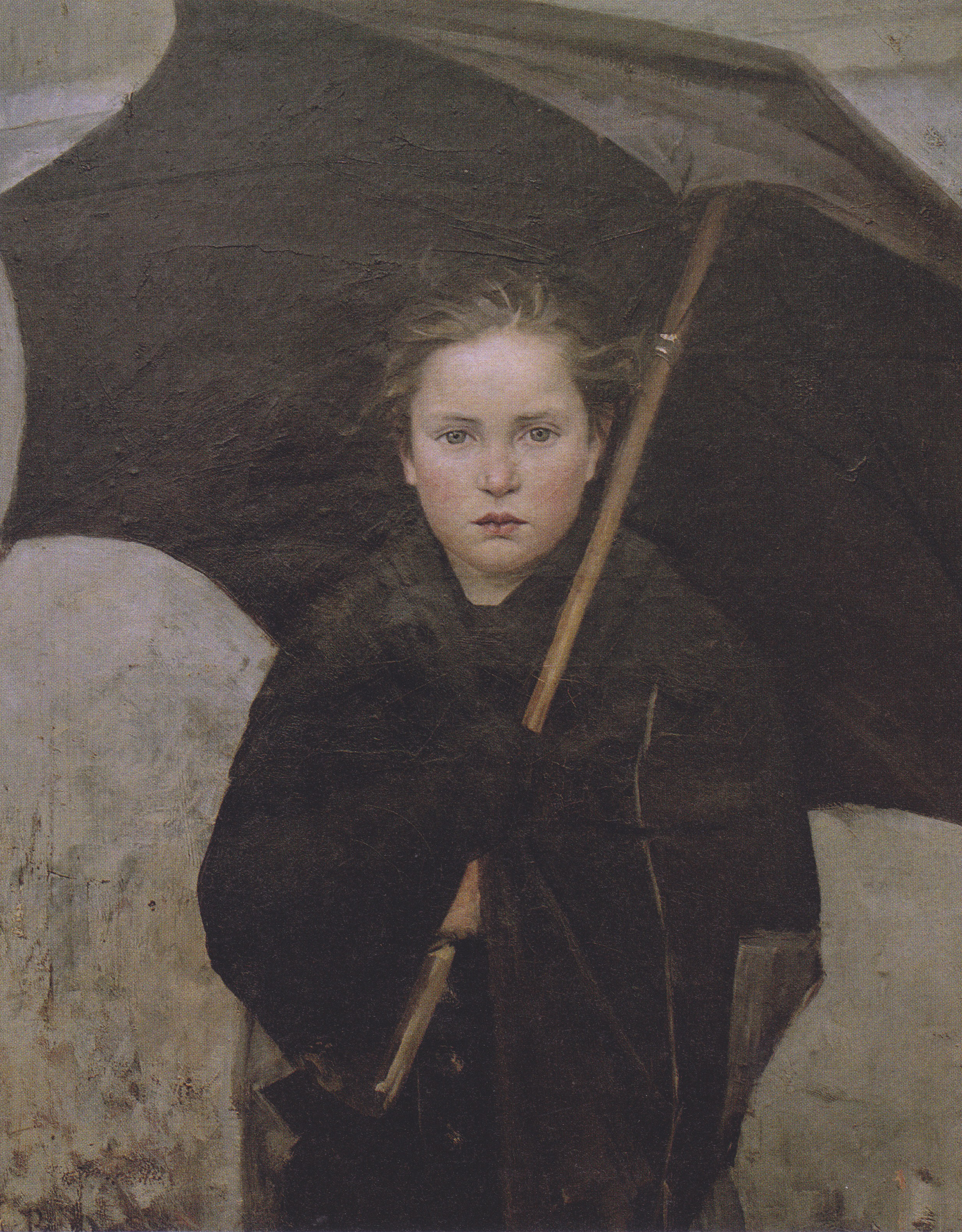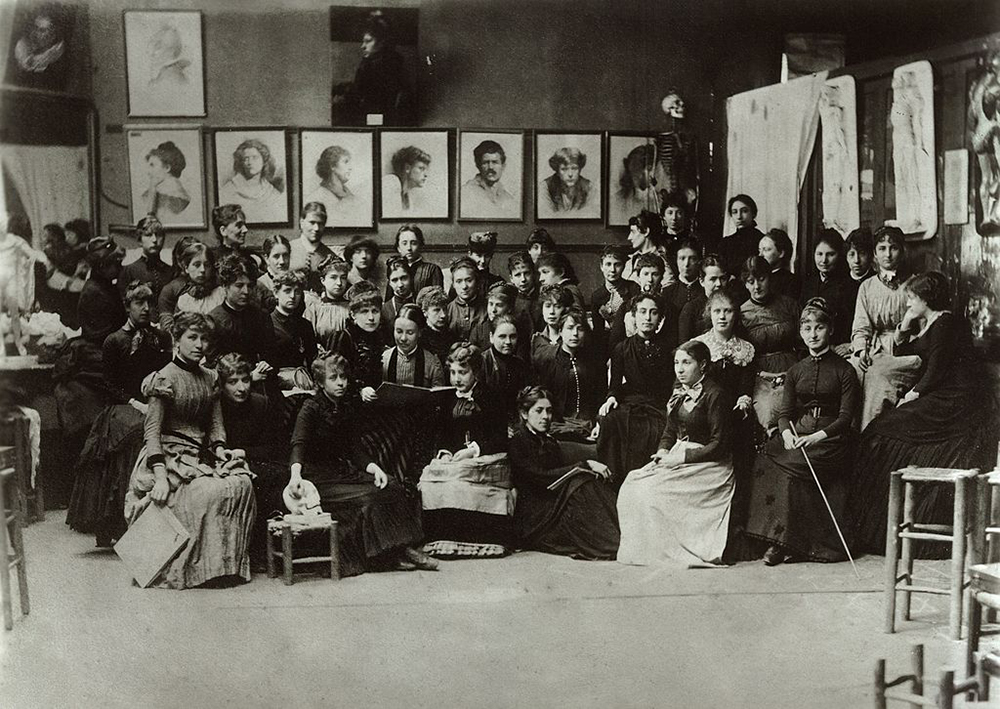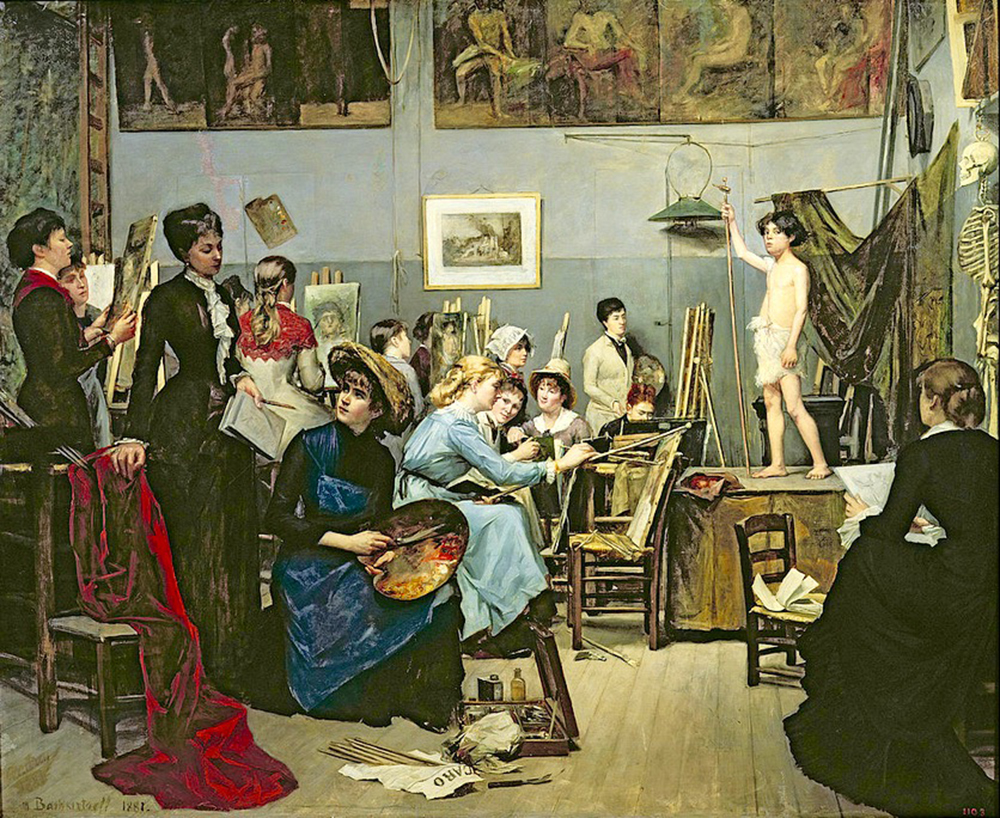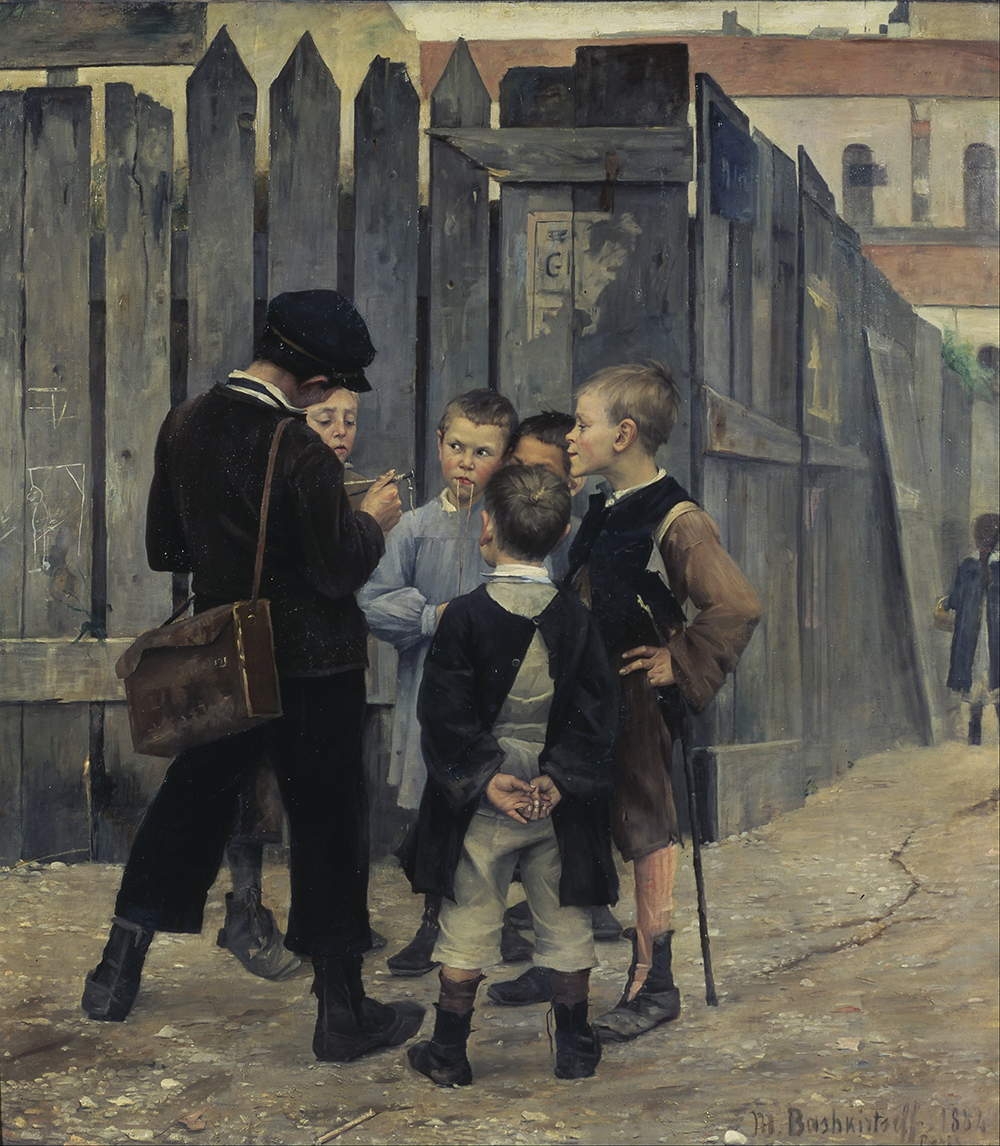
The Umbrella, by Marie Bashkirtseff, 1883. Wikimedia Commons, State Russian Museum.
Many budding American painters, eager to read about and eventually join other young painters abroad, read the journals of the very beautiful and gifted Russian painter Marie Bashkirtseff when they were published in 1887. Her Self-Portrait with Palette had been painted in 1880, and her journals were full of accounts of her studies at the Académie Julian, and her friendship with Rodolphe Julian.
Rodolphe Julian (1839–1907) was described by George Moore, a student at the Académie Julian in 1873, in his Impressions and Opinions, as “a kind of Hercules, dark-haired, strong, with broad shoulders, short legs, a soft voice and with all the charm of the Midi.” Julian often told tales of his village of La Palud in the Vaucluse, where he had lived in Le Jardin, now called the Château Garoutte (at present a salle polyvalente, used as a cultural center for the village).
Julian—a most extraordinarily well-rounded kind of Renaissance honnête homme—had been a wrestler, participating in many of the local tournaments, and had been and remained close to the poets of the Provençal language, especially Frédéric Mistral and the Félibrige writers’ association, devoted to writing and speaking the variety of French called Occitan, in Avignon. He was also a successful illustrator and painter between 1863 and 1879, participating in the Salons. He then gave it all up to open his academy, which grew progressively more successful, to the point of being the best-known art school in Paris outside the Beaux-Arts, the Académie Colarossi, and the Académie de la Grande Chaumière. In 1890 he opened his ateliers at 31 rue du Dragon, aimed at students preparing for the École des Beaux-Arts, competing for the Prix de Rome or presenting their works in the Salons.
In 1959 the Académie Julian was taken over by a larger academy, and later, in 1968, it merged with the atelier Penninghen to become the École supérieure d’arts graphiques.
But its past is truly splendid and includes major figures such as the Nabis artists Maurice Denis, Paul Sérusier, Édouard Vuillard, and Pierre Bonnard; the Fauves Henri Matisse and André Derain; and also Marcel Duchamp, Jean Dubuffet, Jacques Henri Lartigue, Eileen Gray, Henry van de Velde, the poster genius Cassandre, and Robert Rauschenberg, who was there in 1948. There is plentiful testimony about American painters not considering their education complete until they had attended the Académie, and about the solicitousness of Julian himself. One report, typical of the others, reads:
As soon as he had recognized a true vocation in one of those male or female students who came to him, and his interest, once he had perceived the strong perseverance by which one achieves success, he would do everything in his power to help him either materially or by advice and encouragement.
The magnetism of his person seemed unforgettable, according to a witness in November 1909: “As soon as he appeared…there was silence…each one quickly took up again his pencil or his brush and resumed the tireless search for truth according to nature, so greatly was Julian both feared and loved.”
The women painters were on the second floor at the first location, in the passage des Panoramas, and were not able to paint from a nude male model if they were working alongside a male pupil. The students at the Académie Julian were taught by a network of celebrated professors including Jules Joseph Lefebvre; Gustave Boulanger; William-Adolphe Bouguereau; Jean-Paul Laurens; Jean Joseph Benjamin-Constant, who had studied, like Julian, at the Beaux-Arts under Alexandre Cabanel and Léon Cogniet; and Tony Robert-Fleury, who had taught Cecilia Beaux and Anna Elizabeth Klumpke, a close friend of Rosa Bonheur.

As for the magnificently talented, brave, and cultured Marie Bashkirtseff, who died so early of tuberculosis in 1884, she had always thought—known—that she would be immensely celebrated and indeed had always had premonitions that she would die young. Her mother, who edited her journal from the eighty-four notebooks she left—and fudged the dates, so that we will never know exactly when she was born—had her live and die younger than she was, it seems, to make it more dramatic still. She published the journal only three years after Bashkirtseff’s death, and it was read widely by all the women artists we know about, including Berthe Morisot, Julie Manet, and Cecilia Beaux.
The catalogue of the works of Bashkirtseff in 1985 had over two hundred items. She appears to have worked steadily, attempting to dress down to be inconspicuous, always conscious, as she phrased it, “of the bourgeois inability to understand her artistic sentiments.” (Wow.) Perhaps not someone you would have liked, given her essential self-sureness, but how not to gape at the style of the journal? Whether or not you can bring yourself to lament Bashkirtseff’s lack of the talent she had so coveted as a singer, the style itself is admirable. Never mind, Marie said to herself and to the public through her writing, she would either make it through her art, or then her journal; evidently, she did it through both. Here is part of Bashkirtseff’s journal from early on:
Nice, January 1875
I was made for emotions, for success; the best I can do, therefore, is to turn singer…I am of noble extraction and there’s no need for my making a living; this will ensure greater success and enable me to rise with more facility. Life will be perfect thus. I dream of nothing but fame, of being known all the world over.
Nice and Rome, July 2, 1876
To marry and have children! any washerwoman can do that…What do I want? Oh, you know well enough. I want glory.
Paris, April 13, 1876
At twenty-two I shall be either famous or dead.
…I swear that I will become famous; I swear solemnly—by the Gospels, by the passion of Christ, by myself—that in four years I will be famous.
Bashkirtseff certainly did become famous at her death at twenty-six, so in a sense, she was—as she always knew she would be—absolutely correct.

About her work at the Académie Julian, she waxed specific: she was, after all, the first person to insist that women be allowed to paint from the nude model, and the future women students of the academy had every reason to celebrate that insistence. She describes Rodolphe Julian’s visits to her work in the women’s atelier on the passage des Panoramas—it is not devoid of the self-glorification we have seen in the preceding entries, but surely no less interesting. It is Julian himself who takes her to the atelier, where a nude man is posing for the first time:
Paris, October 4, 1877
As for the study from the nude, it came of itself, and M Julian did not correct a single line…He says that sometimes his female students are as clever as the young men…
As long as the painting women had only draped models, Bashkirtseff said, there would have been no problem in working alongside the men, as she believed she would have deserved, but since they now all could make studies from a nude, there would be no further advantage. So she stayed with the women, and wrote in her journal:
Paris, November 17, 1877
And I must tell you that M Julian and the others said at the men’s studio that I had neither the touch, nor the manner, nor the capabilities of a woman, and that they would like to know if there is any one in my family from whom I have inherited so much talent and vigor, nay even brutality, in drawing, and so much perseverance in my work…
Paris, October 6, 1877
As for the study from the nude, it came of itself, and M Julian did not correct a single line. He was not there when I arrived; it was a pupil who told me how to begin; I had never seen a study from the nude before…Julian is pleased with the way I have begun. “By the end of the winter you will be able to paint some very good portraits,” he said to me. I am, oh! so happy.
“Don’t be afraid,” said Julian, “you will get on fast enough.”
And she did indeed, having a painting accepted in the Salon of 1880, a piece of news conveyed to her by Julian himself on April 7 of that year. When all went well in the studio and with Julian, with whom she shared many meals and much conversation, she called him the “illustrious Director of the Folies-Julian” and “Grandpa Julian.” He himself, said one journalist, although he is such an excellent teacher, is modest about that and “gives way to Bouguereau, Tony Robert-Fleury, and others, who are the recognized teachers.”

Bashkirtseff was far from unaware of the glory that her splendid successes brought him. “You urge me on because of the money I bring in and the honor that I may bring to the atelier,” she said. He wanted her to paint a women’s atelier, perhaps the new one on the rue Vivienne, which she did, exhibiting it in the 1881 Salon. A few days before her early death, Robert-Fleury and Rodolphe Julian, the latter of whom she had seen less and less because of his administrative duties, came to dine with her.
It is above all Bashkirtseff’s sure sense of herself that remains with us and which must have encouraged so many women painters. Even as they might discard such sublime self-congratulations, it would be hard not to absorb even a bit of her confidence in one’s own selfness and to appreciate the lyric heights to which her self-assuredness and love of Nature, in which Julian always insisted the painter should find truth, had raised her:
Paris, March 11, 1884
No one, it seems to me, no one loves everything as I do—the fine arts, music, painting, books, society, dress, luxury, excitement, calm, laughter and tears, love, melancholy, humbug, the snow and the sunshine; all the seasons, all atmospheric effects, the silent plains of Russia, and the mountains round Naples; the frost in winter, autumn rains, spring with its caprices, quiet summer days, and beautiful nights bright with stars…I admire, I adore it all. Everything appears to me in an interesting or sublime aspect; I should like to see, possess, embrace it all, be absorbed in time, and die, since I must, in two years or in thirty—die in an ecstasy, in order to analyze this final mystery, this end of all of this divine beginning.
Journal May 1, 1884, preface
If I do not die young, I hope to survive as a great artist; but if I do, I will have my Journal published, which cannot fail to be interesting.
Paris, June 25, 1884
Trying to find what to do. go to Italy? Stop in Paris? Get married? paint? What was to be done? If I went to Italy I couldn’t be in Paris and I wanted to be everywhere at once!! What vigor there was in it all!!!
As a man, I should have conquered Europe. Young girl as I was, I wasted it in excesses of language and silly eccentricities. Oh, misery!…why these mad aspirations towards greatness which I formerly imagined to consist in riches and titles? Why, from the time that I had two consecutive ideas, from the age of four, this desire for things glorious, grand, confused but immense? Ah, what have I not been in my childish dreams!
Reprinted with permission from Creative Gatherings: Meeting Places of Modernism by Mary Ann Caws, published by Reaktion Books Ltd. Copyright © 2019 by Mary Ann Caws. All rights reserved.
